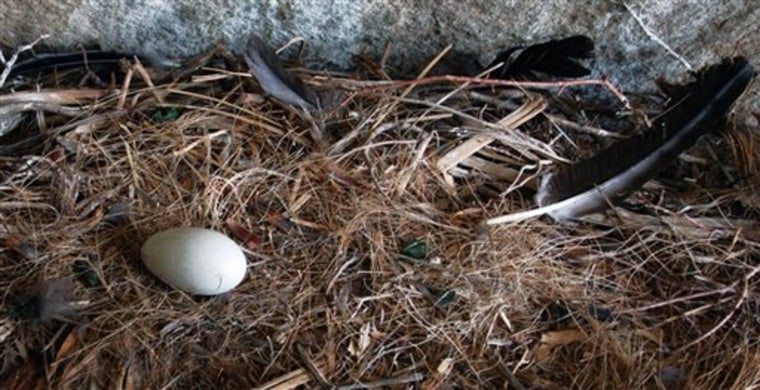A California condor has laid an egg in Mexico for the first time since at least the 1930s, biologists at the Zoological Society of San Diego announced Monday. If the chick hatches and survives, scientists hope it will herald the return of a breeding condor population to Mexico, decades after the iconic giant of the skies was wiped out there.
"This is a momentous occasion," said Dr. Mike Wallace, a field scientist who observed and measured the egg in its nest. "We're all excited."
Wallace and colleagues found the egg March 25 in an abandoned eagle nest on a cliff in the Sierra San Pedro de Martir National Park, located in the arid interior of the Baja California peninsula more than 100 miles (160 kilometers) south of the U.S.-Mexico border.
Wallace climbed to the nest and took photographs and measurements of the egg, shining a bright light through the shell to determine that the egg was 45 to 50 days old. Condor eggs incubate for 57 days, meaning the chick could hatch any day. There was also a chance the egg was dead, but Wallace said he did not smell any sulfur and the parent condors were still tending to it.
"We are all sitting on pins and needles waiting to see where the situation is going," said Wallace, who works for the zoological society's center for Conservation and Research for Endangered Species. The society also runs the San Diego Zoo and its wild animal park.
The California condor was once widespread, swooping above the western United States, parts of Canada and Baja California.
A type of vulture, the condor scavenges dead fish and animals — as coastal population of seals and otters declined, so too did the bird. The use of poison to kill California's grizzly bears in the 1800s also devastated numbers, and lead shot remains a potential source of poison. Hunting, egg collecting and power cables were also blamed for hurting the creature's numbers.
Only 22 California condors were left by the 1980s, and the last documented sighting in Mexico was in the 1930s, Wallace said.
Thanks to a captive-breeding program, numbers recovered to a worldwide total of about 280. More than 100 of these fly free in the skies above parts of California, Nevada and Utah. Working with the Mexican government, biologists reintroduced captive-bred birds to Mexico in 2002.
Condors don't reproduce until they are several years old, Wallace said. The 7-year-old female that laid the egg in Mexico, known as Condor 217, was born at the Los Angeles Zoo.
Weighing up to 26 pounds (12 kilometers) and with a wingspan of almost 10 feet (3 meters), the California condor is one of the world's largest birds. Another species of condor, found in the Andes, is also under threat but its numbers are in the thousands, Wallace said.
Several organizations have been working together to boost condor numbers under the Condor Recovery Program, which was founded in 1982 by the U.S. Fish and Wildlife Service. Among them are several Mexican groups, the Los Angeles Zoo, Peregrine Fund's World Center for Birds of Prey and Oregon Zoo.
